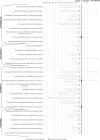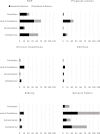Barriers of Influenza Vaccination Intention and Behavior - A Systematic Review of Influenza Vaccine Hesitancy, 2005 - 2016
- PMID: 28125629
- PMCID: PMC5268454
- DOI: 10.1371/journal.pone.0170550
Barriers of Influenza Vaccination Intention and Behavior - A Systematic Review of Influenza Vaccine Hesitancy, 2005 - 2016
Abstract
Background: Influenza vaccine hesitancy is a significant threat to global efforts to reduce the burden of seasonal and pandemic influenza. Potential barriers of influenza vaccination need to be identified to inform interventions to raise awareness, influenza vaccine acceptance and uptake.
Objective: This review aims to (1) identify relevant studies and extract individual barriers of seasonal and pandemic influenza vaccination for risk groups and the general public; and (2) map knowledge gaps in understanding influenza vaccine hesitancy to derive directions for further research and inform interventions in this area.
Methods: Thirteen databases covering the areas of Medicine, Bioscience, Psychology, Sociology and Public Health were searched for peer-reviewed articles published between the years 2005 and 2016. Following the PRISMA approach, 470 articles were selected and analyzed for significant barriers to influenza vaccine uptake or intention. The barriers for different risk groups and flu types were clustered according to a conceptual framework based on the Theory of Planned Behavior and discussed using the 4C model of reasons for non-vaccination.
Results: Most studies were conducted in the American and European region. Health care personnel (HCP) and the general public were the most studied populations, while parental decisions for children at high risk were under-represented. This study also identifies understudied concepts. A lack of confidence, inconvenience, calculation and complacency were identified to different extents as barriers to influenza vaccine uptake in risk groups.
Conclusion: Many different psychological, contextual, sociodemographic and physical barriers that are specific to certain risk groups were identified. While most sociodemographic and physical variables may be significantly related to influenza vaccine hesitancy, they cannot be used to explain its emergence or intensity. Psychological determinants were meaningfully related to uptake and should therefore be measured in a valid and comparable way. A compendium of measurements for future use is suggested as supporting information.
Conflict of interest statement
The authors have declared that no competing interests exist.
Figures





References
-
- WHO. Seasonal Influenza. Fact Sheet. 2014.
-
- WHO. The Global Action Plan for Influenza Vaccines Report of the tenth meeting of the Advisory Group of the WHO Global Action Plan for Influenza Vaccines. 2015.
-
- Poland GA. The 2009–2010 influenza pandemic: effects on pandemic and seasonal vaccine uptake and lessons learned for seasonal vaccination campaigns. Vaccine 2010;28 Suppl 4:D3–13. - PubMed
-
- Mereckiene J, Cotter S, Nicoll A, Levy-Bruhl D, Ferro A, Tridente G, et al. National seasonal influenza vaccination survey in Europe, 2008. Euro Surveill Bull Eur Sur Les Mal Transm = Eur Commun Dis Bull 2008;13. - PubMed
Publication types
MeSH terms
Substances
LinkOut - more resources
Full Text Sources
Other Literature Sources
Medical
Miscellaneous

